The Top 6 Essential Garden Tools for Unwanted Weeds

Gardening offers a slice of nature’s serenity, but unwanted weeds can turn this peaceful activity into a relentless battle. Fortunately, equipping yourself with the right tools can make weeding less of a chore and more of a quick, satisfying task. Here are the top 6 gardening tools to keep your garden pristine with minimal effort.
The Top 6 Essential Garden Tools for Unwanted Weeds
1. Regular Garden Hoe: Your First Line of Defense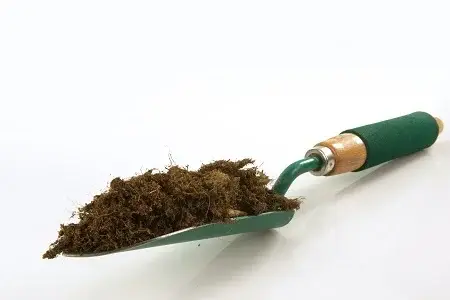
The regular garden hoe stands as a fundamental weapon against weeds. With its sharp, flat blade, this tool excels at slicing through soil to uproot weeds. It’s perfect for tackling large areas quickly,
making it a must-have in your gardening tools. Understanding how to use it effectively can enhance your gardening efficiency and enjoyment.
How to Use
When using a standard garden hoe, the process is relatively straightforward. Firstly, ensure a comfortable grip by holding the hoe firmly with both hands, minimizing fatigue while maintaining control. To position yourself correctly, stand upright to reduce strain on your back and angle the hoe slightly towards the ground.
Now, for the technique: employ a controlled chopping motion to cut through the soil and sever weeds from their roots effectively. After chopping, pull the hoe towards you to gather and remove the weeds.
Pros
- Ideal for gardening tasks, including weeding, soil breaking, and trenching.
- Quickly covers large areas, making it suitable for maintaining bigger gardens.
- Easy to use, requiring no special skills or strength, which makes it accessible for gardeners of all ages and abilities.
Cons
- This can be physically demanding, mainly when used for extended periods or in hard, compacted soil.
- While great for covering large areas, it may not be the best choice for tight spaces or close to delicate plants, where more precise tools would be beneficial.
- The blade requires regular sharpening to cut through soil and weeds effectively.
2. Action Hoe: Precision Weed Control 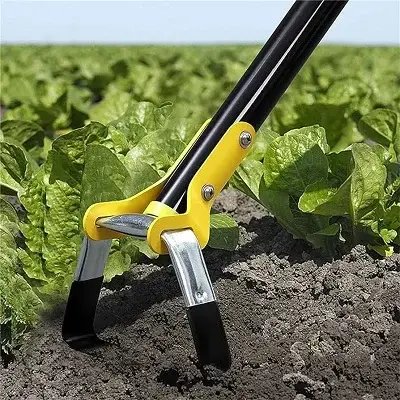
Also known as the loop hoe, the action hoe brings precision to your weeding efforts. Its double-edged blade oscillates on both the push and pull actions to cut weeds below the soil surface. It stands out for its unique cutting action, which offers an efficient and gentle approach to maintaining your garden. Understanding its operation, benefits, and limitations will help you maximize its potential.
How to Use
Using an action hoe is a straightforward process that involves a few key steps. First, ensure you have a firm grip on the handle with both hands, providing better control and leverage. This grip and the right stance can help reduce fatigue, especially during extended use. Unlike traditional hoes, the action hoe is most effective with a back-and-forth motion.
As you glide the hoe forward and backwards, its blade efficiently cuts through the soil and slices weeds at their roots. As you cut the weeds, they’ll be uprooted or sliced at the base, making it easy to collect and remove them from your garden.
Pros
- The double-edged blade cuts on both forward and backward strokes, making weeding fast and reducing the time spent on this task.
- Its design allows for careful weeding around plants and in tight spaces without damaging crops.
- The action hoe’s method of use is less taxing on the back and arms than traditional hoeing, as it requires less forceful motions.
Cons
- Getting used to the back-and-forth motion might take some time, especially if you’re accustomed to traditional hoeing techniques.
- While excellent for surface weeds, it’s less effective against deep-rooted weeds that require a tool designed for digging deeper into the soil.
- Depending on the make and model, the moving parts of an action hoe may require more maintenance or be more prone to wear and tear than simpler, solid tools.
3. Garden Weasel: The Multipurpose Cultivator 
The Garden Weasel isn’t just a weeding tool; it’s a cultivator that aerates and prepares your soil for planting. Its rotary action uproots weeds and loosens the soil, promoting healthy plant growth. Its unique design and ease of use make it a favourite among garden enthusiasts for keeping their gardens in prime condition.
How to Use
Effectively using the Garden Weasel is a simple process that involves a few easy-to-follow steps. Start by gripping the tool firmly, ensuring a comfortable hold that provides good control. Then, as you roll the Garden Weasel over the soil in a back-and-forth motion, its spiked wheels will rotate, effectively penetrating the soil.
Depending on your specific model, you may have the option to adjust the depth. Set the depth according to your gardening task—shallower for weeding and deeper for cultivating and aerating. After passing over a particular area, you may need to manually clear plant debris and weeds from the spikes to maintain the tool’s effectiveness.
Pros
- With its rolling design, the Garden Weasel covers large areas quickly, saving time and effort compared to manual tools.
- It’s effective for multiple tasks, including weeding, aerating, and cultivating soil, making it a 3-in-1 tool for garden maintenance.
- Its design reduces physical strain, making gardening more accessible, especially for those with back problems or limited mobility.
Cons
- While excellent for aerating and breaking up soil, it may not be as effective against deep-rooted weeds, which might require a more targeted approach.
- Works best in looser, more manageable soils and may struggle with very compacted or rocky ground.
- The spikes and moving parts may need regular cleaning and lubrication to maintain optimal performance and prevent rusting.
4. Stirrup Hoe: The Efficient Weeding Solution 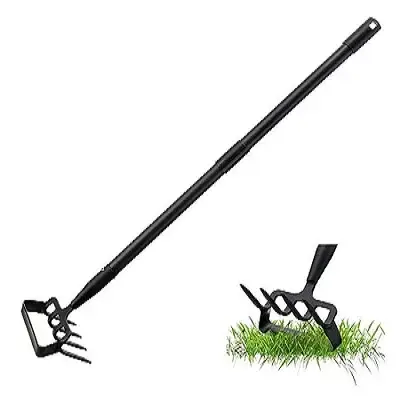
The stirrup hoe, or oscillating hoe, features a moveable blade that cuts weeds below the soil’s surface. Its unique design, resembling a stirrup on a saddle, allows for a swift, back-and-forth motion, cutting weeds just below the soil surface. This tool combines the precision necessary for delicate areas with the strength to tackle tougher weeds, making it a favourite for garden maintenance.
How to Use
Mastering the Stirrup Hoe involves a few essential steps to ensure efficient weeding and soil maintenance. Hold the tool correctly, gripping the handle comfortably to control its movement. To effectively weed, tilt the hoe slightly so that the blade makes optimal contact with the soil, ensuring it reaches the weed roots.
Next, as you glide the Stirrup Hoe smoothly back and forth across the soil surface, its blade will effortlessly slice through the weeds at their roots, removing them with minimal effort. However, clearing the area of any uprooted weeds is essential to prevent them from retaking roots after this process.
Pros
- The oscillating blade allows quick weeding with less effort, as it cuts on both the push and pull movements.
- The design of the stirrup hoe minimizes the need for bending and reduces strain on your back, making weeding less physically demanding.
- It’s effective for weeding between plants and tighter spaces, where precision is critical.
Cons
- Getting used to the back-and-forth motion may take some time, especially if you’re accustomed to traditional hoeing methods.
- While excellent for surface weeds, it might not be the best choice for deep-rooted weeds, which may require a different tool for removal.
- Performs best in softer soils and might struggle in very compact or rocky conditions.
5. Wheel Stirrup Hoe: The Ultimate Weeding Efficiency 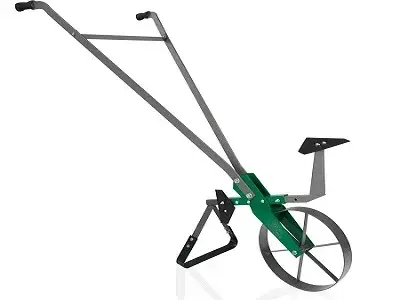
Take the efficiency of the stirrup hoe and put it on wheels; you get the wheel stirrup hoe. This innovation makes weeding easier and faster, covering larger areas with less effort. It combines the effectiveness of the oscillating blade of a stirrup hoe with the ease of use provided by wheels, making it a powerful ally in the fight against weeds.
How to Use
Utilizing the Wheel Stirrup Hoe is straightforward but impactful. One of its greatest advantages is working comfortably upright, reducing the strain on your back. To use it effectively, grip the handles and push the hoe forward, allowing the wheels to roll smoothly across the soil. Interestingly, the Wheel Stirrup Hoe requires less force than traditional hoes, making gardening easier. As you move along, weeds are sliced at their roots, simplifying their removal from your garden.
Pros
- The Wheel Stirrup Hoe allows you to cover more ground in less time, significantly speeding up the weeding process.
- It reduces physical exertion by eliminating the need to bend or kneel, making weeding accessible for gardeners of all ages and abilities.
- Many models offer adjustable handles or blades, allowing you to customize the tool for your height and the specific needs of your garden.
Cons
- The Wheel Stirrup Hoe may have a higher upfront cost than simpler hand tools, but its durability and efficiency justify the investment for serious gardeners.
- Being larger than a traditional home, it requires more storage space, which might be a consideration for those with limited room.
- While perfect for open areas, its size might restrict its use in very tight or densely planted areas where a smaller tool would be more effective.
6. Weed Puller – The Root of the Problem 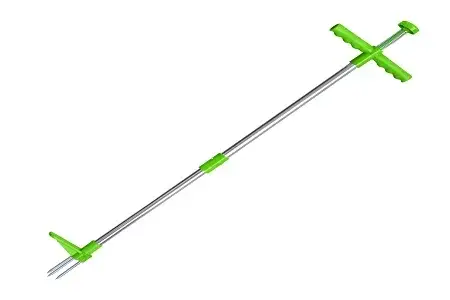
The Weed Puller is a specialized tool designed to remove weeds easily, especially those with deep roots, such as dandelions and thistles. Unlike broad-spectrum weeding tools, the weed puller targets individual weeds, extracting them from the soil with their roots intact. This method prevents the weeds from regrowing, ensuring a more permanent solution to your weed problems.
How to Use
Using a weed puller is a simple and satisfying method for weed removal. First, position the tool by placing its claws over the weed you want to remove, ensuring it is centered over its root. Next, apply pressure by stepping on the foot pedal or pushing the tool down into the ground with your hand, depending on the tool’s design. If the claws have grasped the root, twist the handle if applicable and pull the tool upwards. The weed will be extracted from the ground roots as you do this. Many weed pullers come equipped with a mechanism to release the weed from the claws, making disposal effortless without the need to touch the weed directly.
Pros
- The weed puller is designed to remove weeds with deep roots, ensuring they don’t quickly return.
- Leveraging the tool’s mechanics, weeds can be removed with minimal physical effort and without bending or kneeling.
- This method of weeding doesn’t require chemicals, making it an environmentally friendly option for maintaining your garden.
Cons
- While highly effective, using a weed puller can be time-consuming if you have a large area infested with deep-rooted weeds.
- Some users may find pushing the tool into the ground and pulling it out challenging, especially in hard or compacted soil.
- Compared to simple hand tools, a weed puller might be more expensive, but its effectiveness and durability make it a worthwhile investment.
Some Tips About Weeding
Weeding is a crucial part of maintaining a healthy and beautiful garden. The right approach can make a significant difference in your gardening success. Here are some invaluable tips to enhance your wedding strategy, ensuring your garden remains vibrant and weed-free.
- Timing is Everything: Weed after rain when the soil is moist. It’s easier to pull weeds out completely without breaking them.
- Mulch Matters: Applying a layer of mulch can prevent weed seeds from reaching the soil and sprouting.
- Stay Consistent: Regular weeding keeps your garden tidy and prevents weeds from spreading.
- Use the Right Tool: Match the tool to the type and location of weeds for efficient weeding.
The Bottom Line
Choosing the right tools for the job allows you to maintain a beautiful, weed-free garden with less effort and more satisfaction. Remember, every garden is unique, so finding the perfect combination of tools will make weeding a breeze and leave more time for enjoying the fruits of your labour.










